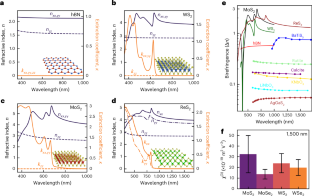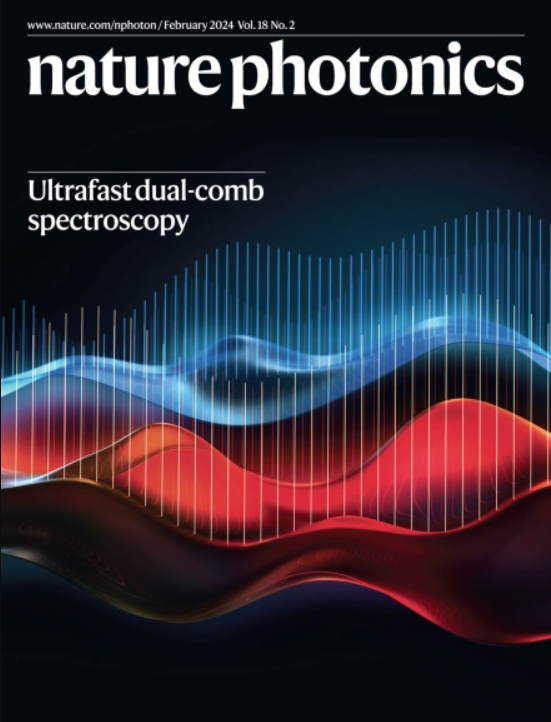多层范德华材料的纳米光子学
IF 32.9
1区 物理与天体物理
Q1 OPTICS
引用次数: 0
摘要
纳米光子学领域需要高质量的材料来制造共振结构,将光限制在纳米尺度。通常用于此目的的金属纳米结构具有高光学损耗,因此高折射率介质如硅(Si)和III-V半导体被广泛使用。最近,层状材料,通常被称为“范德华材料”,用于将原子平面固定在块状晶体中的力,已被引入作为纳米光子学的替代介电构建块。与传统半导体相比,这些材料在可见光和近红外波段表现出更高的折射率和透明度,有利于紧凑的波导;强双折射和大非线性光学系数对非线性光学具有吸引力;面外范德华力使得新的调谐技术和异质积分方法能够实现以前无法实现的光子结构。最近,准体范德华材料的这些特性(与它们广泛研究的单层材料相反)已被应用于各种光子结构和器件中,本文将对此进行讨论。我们报告了层状材料在波导、波前整形、珀塞尔增强、量子纳米光子学、激光、非线性光学和强光-物质耦合等方面的最新进展,并展望了混合和可调谐纳米光子学、三维光子结构、光捕获、极化子器件和范德瓦尔斯集成纳米光子电路的未来发展。本文章由计算机程序翻译,如有差异,请以英文原文为准。


Nanophotonics with multilayer van der Waals materials
The field of nanophotonics requires high-quality materials for the fabrication of resonant structures that can confine light down to the nanoscale. Metallic nanostructures often used for this purpose exhibit high optical losses, so high-refractive-index dielectrics such as silicon (Si) and III–V semiconductors are widely used instead. Recently, layered materials, often referred to as ‘van der Waals materials’ for the forces holding atomic planes together in bulk crystals, have been introduced as alternative dielectric building blocks for nanophotonics. Compared to traditional semiconductors, these materials exhibit higher refractive indices and transparency in the visible and near-infrared favourable for compact waveguides; strong birefringence and large nonlinear optical coefficients attractive for nonlinear optics; and out-of-plane van der Waals adhesive forces enabling novel tuning techniques and heterointegration approaches for the realization of previously inaccessible photonic structures. Recently, these properties of quasi-bulk van der Waals materials (as opposed to their widely studied monolayers) have been applied in a variety of photonic structures and devices, which will be discussed here. We report on recent progress in utilizing layered materials in waveguiding, wavefront shaping, Purcell enhancement, quantum nanophotonics, lasing, nonlinear optics, and strong light–matter coupling, as well as offer a snapshot of future developments in hybrid and tunable nanophotonics, three-dimensional photonic structures, optical trapping, polariton devices and van der Waals integrated nanophotonic circuits. This Review reports the recent progress in utilizing van der Waals layered materials in various nanophotonics applications and provides an overview of their future developments in hybrid and tunable nanophotonics, 3D photonic structures, optical trapping, polariton devices and van der Waals integrated nanophotonic circuits.
求助全文
通过发布文献求助,成功后即可免费获取论文全文。
去求助
来源期刊

Nature Photonics
物理-光学
CiteScore
54.20
自引率
1.70%
发文量
158
审稿时长
12 months
期刊介绍:
Nature Photonics is a monthly journal dedicated to the scientific study and application of light, known as Photonics. It publishes top-quality, peer-reviewed research across all areas of light generation, manipulation, and detection.
The journal encompasses research into the fundamental properties of light and its interactions with matter, as well as the latest developments in optoelectronic devices and emerging photonics applications. Topics covered include lasers, LEDs, imaging, detectors, optoelectronic devices, quantum optics, biophotonics, optical data storage, spectroscopy, fiber optics, solar energy, displays, terahertz technology, nonlinear optics, plasmonics, nanophotonics, and X-rays.
In addition to research papers and review articles summarizing scientific findings in optoelectronics, Nature Photonics also features News and Views pieces and research highlights. It uniquely includes articles on the business aspects of the industry, such as technology commercialization and market analysis, offering a comprehensive perspective on the field.
 求助内容:
求助内容: 应助结果提醒方式:
应助结果提醒方式:


